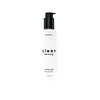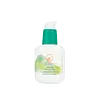What's inside
What's inside
 Key Ingredients
Key Ingredients

No key ingredients
 Benefits
Benefits

 Concerns
Concerns

 Ingredients Side-by-side
Ingredients Side-by-side

Water
Skin ConditioningCocamidopropyl Betaine
CleansingSodium Coco-Sulfate
CleansingRosa Damascena Flower Water
MaskingGlycerin
HumectantRosa Canina Fruit Oil
EmollientCoccinia Indica Fruit Extract
Skin ConditioningFucus Vesiculosus Extract
EmollientMelia Azadirachta Leaf Extract
Skin ConditioningMelia Azadirachta Flower Extract
Skin ConditioningCorallina Officinalis Extract
Skin ConditioningAloe Barbadensis Leaf Juice
Skin ConditioningBetaine
HumectantMethyl Glucose Caprylate/Caprate
Skin ConditioningPhenethyl Alcohol
MaskingSodium Gluconate
Skin ConditioningCocamide Mipa
EmulsifyingPropanediol
SolventCaprylhydroxamic Acid
Sodium Benzoate
MaskingSodium Chloride
MaskingCitric Acid
BufferingPotassium Sorbate
PreservativeGeraniol
PerfumingCitronellol
PerfumingWater, Cocamidopropyl Betaine, Sodium Coco-Sulfate, Rosa Damascena Flower Water, Glycerin, Rosa Canina Fruit Oil, Coccinia Indica Fruit Extract, Fucus Vesiculosus Extract, Melia Azadirachta Leaf Extract, Melia Azadirachta Flower Extract, Corallina Officinalis Extract, Aloe Barbadensis Leaf Juice, Betaine, Methyl Glucose Caprylate/Caprate, Phenethyl Alcohol, Sodium Gluconate, Cocamide Mipa, Propanediol, Caprylhydroxamic Acid, Sodium Benzoate, Sodium Chloride, Citric Acid, Potassium Sorbate, Geraniol, Citronellol
Water
Skin ConditioningGlycerin
HumectantCocamidopropyl Hydroxysultaine
CleansingLactic Acid
BufferingGlycolic Acid
BufferingAloe Barbadensis Leaf Juice
Skin ConditioningSodium Hydroxide
BufferingXanthan Gum
EmulsifyingCalophyllum Inophyllum Seed Oil
AntimicrobialGlyceryl Stearate Se
EmulsifyingMandelic Acid
AntimicrobialMicrocitrus Australasica Fruit Extract
Rosa Canina Fruit Oil
EmollientTartaric Acid
BufferingCaprylic/Capric Triglyceride
MaskingBentonite
AbsorbentSodium Chloride
MaskingSodium Gluconate
Skin ConditioningHydrogenated Lecithin
EmulsifyingCitric Acid
BufferingSodium Stearoyl Lactylate
EmulsifyingQuartz
AbrasiveSodium Benzoate
MaskingSodium Dehydroacetate
PreservativeWater, Glycerin, Cocamidopropyl Hydroxysultaine, Lactic Acid, Glycolic Acid, Aloe Barbadensis Leaf Juice, Sodium Hydroxide, Xanthan Gum, Calophyllum Inophyllum Seed Oil, Glyceryl Stearate Se, Mandelic Acid, Microcitrus Australasica Fruit Extract, Rosa Canina Fruit Oil, Tartaric Acid, Caprylic/Capric Triglyceride, Bentonite, Sodium Chloride, Sodium Gluconate, Hydrogenated Lecithin, Citric Acid, Sodium Stearoyl Lactylate, Quartz, Sodium Benzoate, Sodium Dehydroacetate
 Reviews
Reviews

Ingredients Explained
These ingredients are found in both products.
Ingredients higher up in an ingredient list are typically present in a larger amount.
Aloe Barbadensis Leaf Juice comes from leaves of the aloe plant. Aloe Barbadensis Leaf Juice is best known for helping to soothe sunburns. It is also anti-inflammatory, moisturizing, antiseptic, and can help heal wounds.
Aloe is packed with good stuff including Vitamins A, C, and E. These vitamins are antioxidants, which help fight free-radicals and the damage they may cause. Free-radicals are molecules that may damage your skin cells, such as pollution.
Aloe Barbadensis Leaf Juice also contains sugars. These sugars come in the form of monosaccharides and polysaccharides, folic acid, and choline. These sugars are able to help bind moisture to skin.
It also contains minerals such as calcium, 12 anthraquinones, fatty acids, amino acids, and Vitamin B12.
Learn more about Aloe Barbadensis Leaf JuiceCitric Acid is an alpha hydroxy acid (AHA) naturally found in citrus fruits like oranges, lemons, and limes.
Like other AHAs, citric acid can exfoliate skin by breaking down the bonds that hold dead skin cells together. This helps reveal smoother and brighter skin underneath.
However, this exfoliating effect only happens at high concentrations (20%) which can be hard to find in cosmetic products.
Due to this, citric acid is usually included in small amounts as a pH adjuster. This helps keep products slightly more acidic and compatible with skin's natural pH.
In skincare formulas, citric acid can:
While it can provide some skin benefits, research shows lactic acid and glycolic acid are generally more effective and less irritating exfoliants.
Most citric acid used in skincare today is made by fermenting sugars (usually from molasses). This synthetic version is identical to the natural citrus form but easier to stabilize and use in formulations.
Read more about some other popular AHA's here:
Learn more about Citric AcidGlycerin is already naturally found in your skin. It helps moisturize and protect your skin.
A study from 2016 found glycerin to be more effective as a humectant than AHAs and hyaluronic acid.
As a humectant, it helps the skin stay hydrated by pulling moisture to your skin. The low molecular weight of glycerin allows it to pull moisture into the deeper layers of your skin.
Hydrated skin improves your skin barrier; Your skin barrier helps protect against irritants and bacteria.
Glycerin has also been found to have antimicrobial and antiviral properties. Due to these properties, glycerin is often used in wound and burn treatments.
In cosmetics, glycerin is usually derived from plants such as soybean or palm. However, it can also be sourced from animals, such as tallow or animal fat.
This ingredient is organic, colorless, odorless, and non-toxic.
Glycerin is the name for this ingredient in American English. British English uses Glycerol/Glycerine.
Learn more about GlycerinRosehip Oil is a non-fragrant plant oil. Rosehips are a fruit from a rose bush and are edible. This oil has skin conditioning and hydrating properties.
Rosehip contains Vitamin C, Vitamin E, fatty acids and linolenic acids. These nourish your skin barrier. Having hydrated skin may help reduce the appearance of fine-lines and wrinkles.
Another great component of Rosehip Oil is Vitamin A, or retinol. Vitamin A encourages your skin to create more collagen.
Rosehip oil may help with reducing pigmentation. The lycopene and beta-carotene have skin-lightening properties. However, more studies are needed to confirm this.
Learn more about Rosa Canina Fruit OilSodium Benzoate is a preservative. It's used in both cosmetic and food products to inhibit the growth of mold and bacteria. It is typically produced synthetically.
Both the US FDA and EU Health Committee have approved the use of sodium benzoate. In the US, levels of 0.1% (of the total product) are allowed.
Sodium benzoate works as a preservative by inhibiting the growth of bacteria inside of cells. It prevents the cell from fermenting a type of sugar using an enzyme called phosphofructokinase.
It is the salt of benzoic acid. Foods containing sodium benzoate include soda, salad dressings, condiments, fruit juices, wines, and snack foods.
Studies for using ascorbic acid and sodium benzoate in cosmetics are lacking, especially in skincare routines with multiple steps.
We always recommend speaking with a professional, such as a dermatologist, if you have any concerns.
Learn more about Sodium BenzoateChances are, you eat sodium chloride every day. Sodium Chloride is also known as table salt.
This ingredient has many purposes in skincare: thickener, emulsifier, and exfoliator.
You'll most likely find this ingredient in cleansers where it is used to create a gel-like texture. As an emulsifier, it also prevents ingredients from separating.
There is much debate on whether this ingredient is comedogenic. The short answer - comedogenic ratings don't tell the whole story. Learn more about comegodenic ratings here.
The concensus about this ingredient causing acne seems to be divided. Research is needed to understand if this ingredient does cause acne.
Scrubs may use salt as the primary exfoliating ingredient.
Learn more about Sodium ChlorideThis is the synthetic salt of gluconic acid, a form of PHA and mild exfoliant.
It is mainly used to stabilize oil and butter formulations from going bad. Sodium gluconate is a humectant, pH regulator, and chelating agent.
Chelating agents help neutralize unwanted metals from affecting the formulation.
Sodium gluconate is water-soluble.
Learn more about Sodium GluconateWater. It's the most common cosmetic ingredient of all. You'll usually see it at the top of ingredient lists, meaning that it makes up the largest part of the product.
So why is it so popular? Water most often acts as a solvent - this means that it helps dissolve other ingredients into the formulation.
You'll also recognize water as that liquid we all need to stay alive. If you see this, drink a glass of water. Stay hydrated!
Learn more about Water